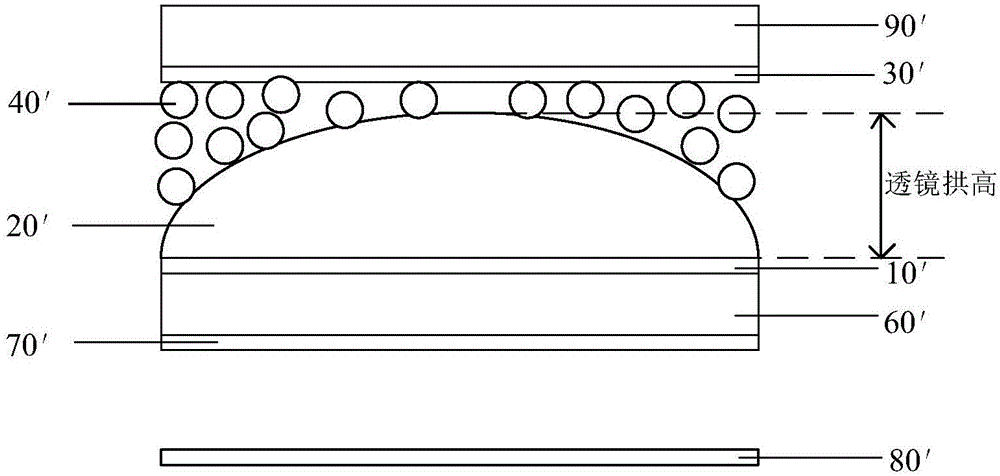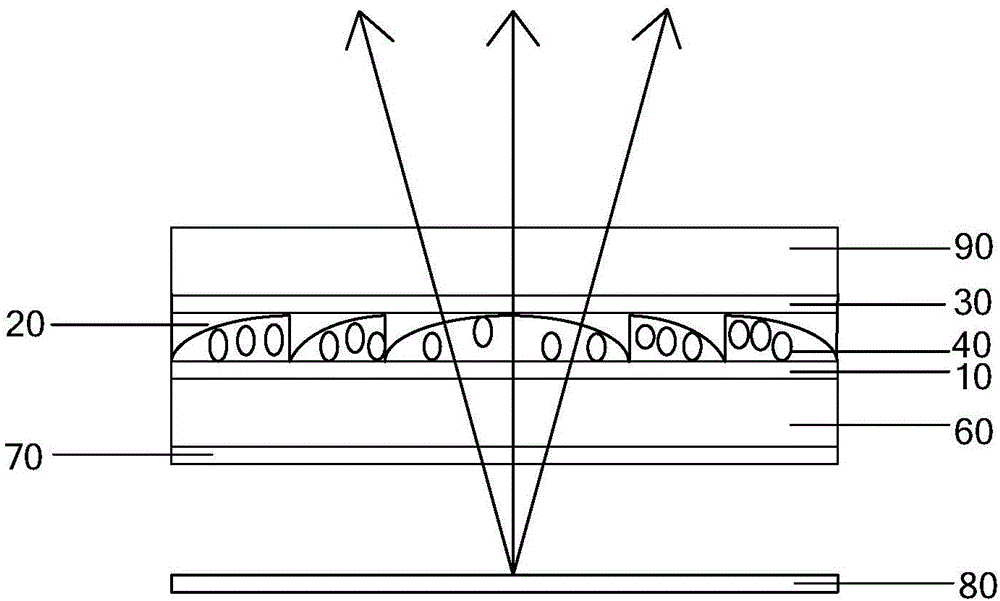Three-dimensional display device
A three-dimensional display device and wedge-shaped technology, applied in the field of 3D display, can solve the problems of high lens arch and long response time of liquid crystal molecules, etc., achieve the effect of shortening the response time, reducing the difficulty and cost of research and development, and solving the effect of excessively long response time
- Summary
- Abstract
- Description
- Claims
- Application Information
AI Technical Summary
Problems solved by technology
Method used
Image
Examples
Embodiment 1
[0045] The stereoscopic display device provided by this embodiment includes a stacked display panel, a polarizer, a first transparent substrate, a first transparent conductive layer, a Fresnel lens complementary layer, a second transparent conductive layer and a second transparent substrate, Fresnel The surface of the lens complementary layer towards the first transparent conductive layer 10 is a concave surface, the concave surface of the Fresnel lens complementary layer includes a plurality of concentric arc surfaces, the concave surface is arranged towards the first transparent conductive layer, and the stereoscopic display device also includes filling in the concave surface and The liquid crystal layer between the first transparent conductive layers, the liquid crystal layer is a vertical alignment type liquid crystal layer, and the three-dimensional display device has a first state when the power is turned off, and the refractive index n of the liquid crystal layer is now ...
Embodiment 2
[0047] The difference between the stereoscopic display device provided in this embodiment and Embodiment 1 is:
[0048] The stereoscopic display device also includes a supporting portion corresponding to each arc surface and arranged close to the first transparent conductive layer, the refractive index of the supporting portion is equal to the refractive index of the Fresnel lens complementary layer, and the surface of the supporting portion opposite to the arc surface is opposite to the first transparent conductive layer. The extension surface of the second transparent conductive layer is an inclined surface, the liquid crystal molecules in the liquid crystal layer are respectively arranged in the closed space between the arc surface and the corresponding inclined surface, the support part is a wedge, and the inclined surface is the upper bottom surface of the wedge , the lower bottom surface of the wedge is in contact with the first transparent conductive layer, the angle bet...
Embodiment 3
[0050] The difference between the stereoscopic display device provided in this embodiment and Embodiment 2 lies in:
[0051] The arc surfaces are connected by connecting surfaces, and the side surfaces of the wedge-shaped bodies are in contact with the connecting surfaces to set up the wedge-shaped bodies.
PUM
| Property | Measurement | Unit |
|---|---|---|
| angle | aaaaa | aaaaa |
| angle | aaaaa | aaaaa |
| refractive index | aaaaa | aaaaa |
Abstract
Description
Claims
Application Information
 Login to View More
Login to View More - R&D
- Intellectual Property
- Life Sciences
- Materials
- Tech Scout
- Unparalleled Data Quality
- Higher Quality Content
- 60% Fewer Hallucinations
Browse by: Latest US Patents, China's latest patents, Technical Efficacy Thesaurus, Application Domain, Technology Topic, Popular Technical Reports.
© 2025 PatSnap. All rights reserved.Legal|Privacy policy|Modern Slavery Act Transparency Statement|Sitemap|About US| Contact US: help@patsnap.com



